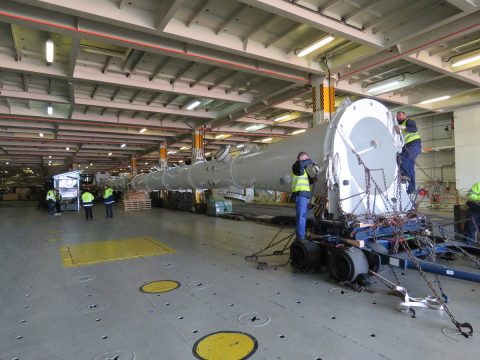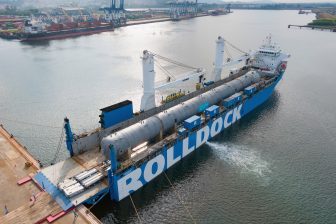
WW: “4,000 cbm of project cargo is our sweet spot”
Wallenius Wilhelmsen is heavily investing in the expansion of its breakbulk business. But rather than just being another competitor, the ro/ro company considers itself to be complementary to the traditional breakbulk carriers. “In terms of volume, our sweet spot per sailing is much lower compared to that of multipurpose vessel operators”, says senior breakbulk manager Vedran Muratbegovic.
To start, how much breakbulk are you currently transporting and have you set any specific targets you want to reach?
“On an annual basis, we transport over two million cubic metres of breakbulk globally and continue to see new opportunities in this segment. Breakbulk is considered key to the optimisation of ro/ro vessels, which require the right cargo mix – meaning the right combination of Breakbulk, High & Heavy and Automotive cargoes – to be fully optimised. We see the business development and therefore growth in this segment as an infinite game rather than something that has a fixed end goal after which our objective is reached.”
How do you distinguish between High & Heavy and breakbulk?
“We define High & Heavy as self-propelled rolling equipment, typically covering various agricultural, mining and construction equipment ranging from trucks and tractors to excavators and bulldozers. Breakbulk, on the other hand, is mostly made up of static cargoes which can either be loaded loose on board the vessel or placed on purpose-built trailers. There are some cases where the distinction is less obvious, for example, in the case of a crane, which could either be completely dismantled and shipped as purely static or have the main unit shipped as RoRo with the remainder dismantled and shipped as static. Either way, we consider cranes to be breakbulk as the majority of the cargo is static.”
Wallenius Wilhelmsen seems to be putting significant effort into promoting ro/ro shipping as a breakbulk solution. Can you elaborate on your strategy?
“We see the market understanding as a critical factor in growing this segment. At the moment, ro/ro shipping is not always top of mind when it comes to shipping breakbulk. We have, therefore, created a program called the ‘Ro/ro Academy’, which is aimed at familiarizing and educating our partners on how we handle cargoes on board and in port. We run this program approximately 8-10 times per year covering all regions of the globe.”
Comparing yourself to traditional breakbulk carriers, how competitive is a ro/ro vessel?
“Both have their strengths and will continue to be relevant to breakbulk shipping. The strengths of our liner services are the high and regular sailing frequencies and fixed transit times, which combined contribute to a more predictable supply chain. Ro/ro shipping also involves minimal lifting making cargo handling significantly safer. On the other hand, multipurpose vessels offer far superior capacities on a single voyage basis and greater flexibility in (the type of exit and entry) ports.”
You wouldn’t charter a 12,500 dwt vessel for 2,500 cbm – 4,000 cbm of breakbulk cargo.
When would you advise customers to ship their breakbulk on a ro/ro vessel?
“Ro/ro makes sense for lower volume project cargo or for the shipment of large projects when shippers are looking to optimize their supply chain. This means carrying the cargo in divided volumes at frequent intervals on liner-style services, rather than shipping the entire volume at once, which could potentially lead to capacity constraints at discharge. You wouldn’t charter a 12,500 dwt vessel for 2,500 cbm – 4,000 cbm of breakbulk cargo alone, but for us, that is so to say our sweet spot. Ro/ro vessels and multipurpose carriers are often considered to be in competition and naturally, this sometimes is the case, but we believe these two should predominantly be seen as being complementary to each other. The lower volume project cargo that is ideal for us is often of less interest to MPV-operators.”
Speaking at last year’s Project Cargo Summit, you mentioned that WW only transports breakbulk on the existing liner services and does not offer flexible pick-ups. Is this still the case now the car industry is in a slump?
“We operate liner-style deep-sea ocean services but for project cargoes that require us to call ports outside of our regular network, we do allow for flexibility and this is something that we do frequently. We assess these requests on a case-by-case basis.”
Anything we thought we knew or expected from the market no longer applies.
Are you planning to expand your range of breakbulk services and if so, in what way?
“We already own and operate a large equipment fleet and have ro/ro vessels that can take a wider range of breakbulk cargoes, but we’re continuously looking for ways to innovate and recognise gaps in the market to add value to customers. For example, we have recently purchased a 750-tonne mobile crane for our terminal in Zeebrugge which eliminates our reliance on third-party cranes, bringing increased efficiencies to customers. Right now, we’re developing a new type of equipment that will provide more flexibility in the handling of heavier units and offer better space utilization for smaller breakbulk cargoes. This is still work in progress but we hope to finish it soon.”
With High & Heavy, WW has a strong presence in the mining, construction and agricultural industries. What other markets are you targeting with your breakbulk division and which do you expect most of?
“Our customer base stretches across many segments such as Oil & Gas, Power and Energy, Machinery, Rail, Aviation, Yachts and Boat. Looking forward we are focusing on the development of new segments such as offshore wind, which seems to be on a never-ending upward trajectory. Given the current COVID-19 situation, however, it is extremely difficult to predict how markets will develop. Which markets will lead the rebound and when that will be is yet to be seen and something we will monitor closely. At the moment, anything we thought we knew or expected from the market no longer applies.”


